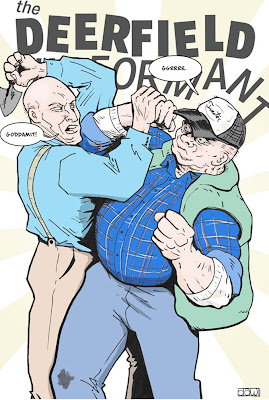
Dropping in to promote my s#!t. Thought you'd like to check out my webcomic The Deerfield Informant. It's got real curmudgeon action at it's most geriatric. This was a full pager to direct the story into a new beginning. Which is what this project feels like every week. It's a work-in-progress.
Viewing: Blog Posts Tagged with: Webcomic, Most Recent at Top [Help]
Results 26 - 36 of 36
Blog: Sugar Frosted Goodness (Login to Add to MyJacketFlap)
JacketFlap tags: webcomic, brandon dawley, deerfield informant, Add a tag
Blog: Sarah McIntyre (Login to Add to MyJacketFlap)
JacketFlap tags: webcomic, cyrano, Add a tag
Hooray, here's my Cyrano comic! I could do a lot of these. I perhaps should've ended it with the second page, but I thought Ragueneau could use some company. Poor Sister Marthe is really a very minor character in the story.
And now I ought get back to the day job.
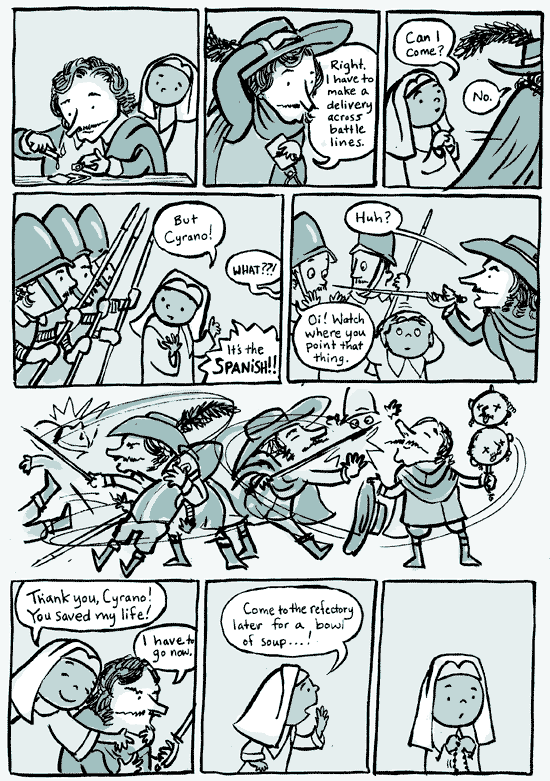
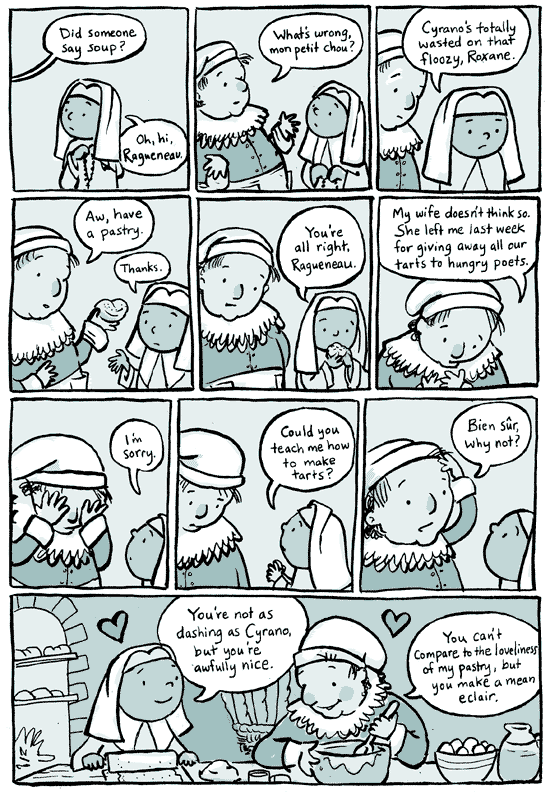
Blog: Sugar Frosted Goodness (Login to Add to MyJacketFlap)
JacketFlap tags: webcomic, brandon dawley, deerfield informant, Add a tag
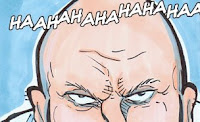
Just taking a moment to let the SFGer's know that I posted the latest episode of The Deerfield Informant somewhere on the internet.
I started it out as black & blue but I think full color is easier to view with my style. I hope you can find the time to check it out. I figured since this is taking up my time from posting here, then I should post about it.
here. thanks.
Blog: Sarah McIntyre (Login to Add to MyJacketFlap)
JacketFlap tags: webcomic, Add a tag

I still can't get my head around why this funny person I live with acts so finicky about the messes I make, but can't brush his teeth without merrily leaving the mirror coated in spray. I tried to show him this technique in which one holds one's lips securely around the brush and moves it around without opening one's mouth, but I think he revels in this singular glorious moment of domestic flamboyance.
I was just friended by ![]() bsabo and discovered the amazing comics and illustration work on her website, have a look! You can read two mini comics in full online (I love the storytelling in The Shortcut), and see first chapters of two books. I really want to read more of her comic Bad Lands.
bsabo and discovered the amazing comics and illustration work on her website, have a look! You can read two mini comics in full online (I love the storytelling in The Shortcut), and see first chapters of two books. I really want to read more of her comic Bad Lands.![]() tozocomic is introducing us to the second little mecha-golem in his ongoing Tozo webcomic. I think Klikker's fab (see my fan art), and I think I'm going to like this Tikker, too!
tozocomic is introducing us to the second little mecha-golem in his ongoing Tozo webcomic. I think Klikker's fab (see my fan art), and I think I'm going to like this Tikker, too!
And ![]() ellenlindner referred me to this great New York Times article about the classless classiness of the Obamas on their recent visit to Britain. (Thanks, Ellen!)
ellenlindner referred me to this great New York Times article about the classless classiness of the Obamas on their recent visit to Britain. (Thanks, Ellen!)
Blog: Sarah McIntyre (Login to Add to MyJacketFlap)
JacketFlap tags: webcomic, Add a tag
Blog: LadyStar (Login to Add to MyJacketFlap)
JacketFlap tags: comics, Lore, fantasy adventure, myths and legends, enchanted, webcomic, Jessica Hoshi and the Ajan Warriors, dragon sword, sunrise warrior, Add a tag
Blog: How To Be A Children's Book Illustrator (Login to Add to MyJacketFlap)
JacketFlap tags: illustrator, cartoons, Manga, Nancy Drew, cartooning, Corel Painter, Adobe Illustrator, comic books, Trina Robbins, Webcomic, feature interview, "A Dog a Day", "Calvin and Hobbes", "For Better or For Worse", "Hex Libris", "Prince Valiant", "Raising La Belle", 2 Bad Mice Design, Art School at the Austin Museum of Art, California State University Summer Arts Workshop, cartoonist, child-friendly, Erik Kuntz, funny pages, How to be a children's book illustrator, kid-friendly, Lynn Johnston, Maggie Gallant, Mark Mitchell, Scott McCloud, Add a tag
Who is the creature lurking in the library in Erik’s comic strip? I think I know, and I’ve entered Erik’s contest, but I can’t share my guess with anyone. But I will say this much — it’s a character from a book we know. After all, the strip is Hex Libris, in which Kirby, the main character is charged with taking care of a ginormous enchanted library.
Ever read a novel that just comes to life before your eyes? Well you can expect Hex Libris to take that theme and … ramp it up a little for you.
The serial web comic by designer-writer Erik Kuntz of Austin, Texas began as a New Year’s resolution. So did his illustrator’s blog A Dog a Day that features Erik’s unstop able canine imagery — with a doggy bite of daily commentary. But that’s a subject for the next post.
Erik was thinking of the classic Nancy Drew stories of the 1950’s, mulling how they contrasted and compared with the Nancy Drew graphic novels that are being designed for today’s teens.
“I wondered, ‘What if there was a place where characters could wander out of their books?’ ” Erik says. ”‘And what would happen if the real Nancy Drew ran into the punky Manga style Nancy Drew?’”
Our hero Kirby meets them both as a result of his new archival responsibilities. And so it is inevitable that the trio and who knows who else (stay tuned…) join forces to solve a mystery, or two.
The story unfolds in semi-weekly panels that move us easily, cleanly and sweetly through time and space. We care about Kirby and Amy (a girl who likes him) and girl detective Connie Carter ( the “original” Nancy Drew) and even the little old lady (or is she a witch?) who leases Kirby the uptown apartment that somehow, magically contains a Library of Congress-like basilica within its tiny walls.
It’s an idea Erik hatched at last year’s Summer Arts Workshop at California State University. He studied comics and animation in the summer program. One of the teachers, Trina Robbins (a comic book writer and illustrator since the 1960s) encouraged him.
“As much as I love comic books, it’s the comic pages in the Sunday paper that I most enjoy and try to emulate here — their sequential nature and the art style and sense of humor — especially from the 40s to the 50s, where they could work bigger and there was more possibility,” he says.
Kuntz blends his pop knowledge with early 20th century literacy, opening his ”chapters” with such verbiage as “In which our hero acquires new lodgings and meets a mysterious young woman ….”
“It tells you what will happen without giving it away,” he explains. ”With a serial web strip, just like in the Sunday funny papers, you kind of need to have a stop every day. You want each page of the comic to be a beat Each one has to be a sort of mini cliff hanger. And each chapter must have its own arc. That’s the other thing I work with to get right.”
Erik begins by writing a synopsis of what’s going to happen in the chapter, without the dialogue.
Then he begins to sketch and figure out the panels and individual frames,” he says.
“I scanned [pencil on paper] sketches for the early strips, but now I’m working directly on the computer, starting with rough sketches in Corel Painter using my Wacom Cintiq tablet monitor,” he says. “I stay with Painter through the inking process, then I bring the whole thing into Illustrator to do the lettering. Once in a while, when I’m out and about with my sketchbook, I capture a pose I want to use and scan that in and mix it in with my computer sketches.
“To be more precise, I use Painter’s Mechanical Pencil brush set to a light blue color. When I ink I use a variety of Painter’s Ink Pen brushes, mostly the Smooth Round Pen one. For the next one, I’m going to experiment with the tools that more closely imitate traditional comics inking brushes: it’ll be looser and I am not certain whether I’ll like it.
“I’ll know in a day or two when I get to the inking. “
Here’s Erik’s ‘pencil rough’ for the March 13 panel of ‘Hex Libris” — except he’s done it digitally.
“They look a lot like my traditional sketches look, since I use a col-erase blue to do my roughs on paper,” he says.
“I’m most of the way done with this roughing, I have some poses to adjust, some faces to finish and I’ve got to fix the perspective on the backgrounds, which are currently just scribbled in. Oh, and I need a background in the final panel. Painter has a perspective grid, which is useful for simple 2-point perspective, so I’ll be using that to get the kitchen sorted properly.
Erik has been a student of
I’ve done so much study over the last few years as to what makes a comic a comic as opposed to an illustrated story,” Erik says. ”It’s a constant struggle between what needs to be put in the picture and what needs to be said ‘out loud’ in words.”
For inspiration, Kuntz looks to the late “father of Manga” Osamu Tezuka (”Kimba the White Lion was my favorite show as a kid,” Kuntz says. “It was cartoony without being overly simple.”
He also draws from the late E.C. Seegar, the creator of Popeye and Thimble Theatre. “I like the older style of newspaper comics, where the adventure strips had a more realistic look.”
There are a huge number of ppl doing them now.
Early days, doing tremendously.
Most of them are very poor. You won’t get it if you weren’t out drinking the night before.
There are quite a few brilliant child-friendly comics.
Some people thew business model is web advertising, especially if you’re drawn to a certain one,.
Penny-Arcade.com..
If you don’t lnpw anything about video games you’;lbe mystified by the strip,
Advertising art.
Others are off advertising on their site, or sales of merchandize, T-shirts and print versions of ytheir work, and their artisitic expression and online portfolio.
I wouldn’t think that ppl doing the webcomics,
Aren’tmakiny money,
There is a stunning amount of good work out there, on the web, and a much
Web an ideal way for me to do a serial.
Web is an inexpensive way to put the work out there and much easier way to get it in front of somebody.
With the web and the social network everyone’s sharing things, pointg it tout toe each other, it’s a new milleu, an old art form anbut a different way of delivering it.
could do it free,
I think every artist that does children’s stuff, cartoony stuff.
Kids are more ., kids are reading comics on the web.
My web brouwser, opens all the comics I want to each in tabs. I don’t read them in the newspaper.
Traditional newspaper strips,
Calving and Hobbes being run again and again on the web. They syndicate.
Kidsa nolw reading Calvin and Hobbes on the web.,
Hald of them are newspaper strips and half are web only strips.
The interesting thing about comics is it could be a way to get ppl to your site,
Comic and the dog thing, anything they want to like and put elsewhere they can put ,
Imbedded my website address into the picture,
Then they canb
Its hard for everyone to say, content is not as sacred than it used to be.
url on the left, name and copyright infor

Blog: Plot Whisperer for Writers and Readers (Login to Add to MyJacketFlap)
JacketFlap tags: Character Emotional Development, PLot Planner, POV, PLot Planner, Character Emotional Development, Add a tag
Q: My current story has my two main characters. The P.O.V. shifts from one to another in alternating chapters as the chase continues to a surprising climactic ending. I have written a plot summary (chapter by chapter so I know where it is going) and what the arc of the story will be. I have completed three chapters so far, but would appreciate any tips you might share with me on plotting my story with a shifting P.O.V. in this way
A: A quick tip I can give you is this ~~ on your banner paper, draw two plot planner lines, one above the other. One each for the two major characters. Use these lines to plot out their individual plots. Develop a plot profile for each to help with their individual character transformations. This way you're ensured to have two deeply developed characters and are able to plot out their individual stories and how the two intertwine with each other.
Blog: Plot Whisperer for Writers and Readers (Login to Add to MyJacketFlap)
JacketFlap tags: Dramatic Action, Character Emotional Development, scene tracker template, Thematic Significance, Elements of plot, PLot Planner, plot writing, Character Emotional Development, Elements of plot, plot writing, Thematic Significance, Dramatic Action, scene tracker template, PLot Planner, Add a tag
The following are questions that came up after the last post. Thought the questions and answers might help other writers so I include them below. Happy plotting...
Q: So basically it’s the scene(s) in the climax section that we have to watch out for in terms of the final CED, to see if the character has evolved from the initial fatal flaw in the beginning of the story?
A: Yes, the scene in the Climax is what each and every scene has been driving towards throughout the entire story, which is why it's a good practice NOT to go back and start over again until you have written all the way to the Climax and are pretty sure what that scene is. If you find yourself in that cycle of constantly going back and beginning again, you'll perfect those early scenes that may end up being cut when you finally understand the Climax. Once you know the Climax, you have a much better idea of how best to begin the project.
Q: And what you are saying is that it is suffice by just marking it in a different color to denote the arc or character journey in emotional development? Subplots, therefore don’t need to be marked separately in Plot Planner because it is intertwined within the Dramatic Action?
A: Some subplots deserve their own Plot Planner. In that case I recommend that one line is above the other so you can see how the subplot works with the major Dramatic Action and Character Emotional Development plot.
Q: On the last question, so summaries don’t show thematic details?
A: On a subtle level, thematic significance shows up everywhere ~~ in scene and summary ~~ though word choice, mood, etc. However, you only plot out scenes on the Plot Planner and on the Scene Tracker.
Q: (Anyways, how would we know to mark the summaries for Theme in plot planner if we don’t even track that info in scene tracker). Is my understanding then to just mark those scenes (not summaries) whether above or below the line, that have thematic details, correct?
A: This is true only in later drafts. The Thematic Signficance does not always emerge until after the story becomes more stable ~~ beyond the first couple of drafts. In the early drafts, don't worry about the Thematic Significance. You'll have enough to work with just honing down the Dramatic Action plot and the Character Development plot.
I apologize if I seem to be reiterating my questions, I just want to make sure I am interpreting your response correctly. I know you are extremely busy and I really do appreciate all of your help.
ps. You're right, PP and ST is addicting. And I have resumed back to my writing with more confidence! By the way, I ordered your DVD with the focus on CHildren Writers and eagerly await to be enlightened by your method again. Perhaps by watching you explain your method, I'll get a greater sense on everything you have written in your book.
A: Yes, I believe you will get a greater sense of how the Plot Planner works and how the Character Development profile helps to build the Character Development plot line. Let me know what you think.
Q: Was also wondering, are all of your DVD workshops pretty similiar and touch on everything that is on the book or do you delve into any advance topics on plotting for example with the DVD you have that uses Memoir of a Geisha?
A: The DVDs are different in that they are live workshops that were taped (some better in quality than others).
Thanks in advance Martha for everything and for your continued support!!!
A: Thank you, and great good luck with your project!
Blog: Plot Whisperer for Writers and Readers (Login to Add to MyJacketFlap)
JacketFlap tags: Dramatic Action, PLot Planner, subplot, Character emotional devleopment, Plot, Dramatic Action, PLot Planner, Character emotional devleopment, subplot, Add a tag
The following are questions Livvy had after my responses in the 10/11 post below.
Q: I did have a question on your Folly example (note: Folly is a mystery by Laurie R. King). You said to use one color to write “arrival” to note Dramatic Action above the line? Then you said to use another color to write “fragile” to note the Character Emotional Development below the line? So am I supposed to plot two points for the same scene? I thought it was either or. Or are you saying for the initial CED, to just note it underneath “arrival” above the line in a separate color just to distinguish it from each other as the beginning emotion? So then for future CED tracking, do I keep it below the line?
A: Yes, to your first question. Both the Dramatic Action (DA) notation and the Character Emotional Development (CED) notations go above the line with different colors to distinquish from each other. Why above the line? Because in the arrival scene we know that the Character is not in control due to her emotional state and the reality of what she has undertaken. Therefore, there is conflict, tension and suspense in the scene and so, belongs above the line.
No is my answer for your second question. The only CED notations that go below the line are the ones where the protagonist is in control. For instance, when she throw away all her medication, we know that in that moment she is in control. This dramatic action is a major symbol of how she is trying to become even more in control of her life.
Q: Are the CEDs that are plotted below the line supposed to show just the progression of the protagonist’s internal flaw or is there a way to show a relationship subplot as well?
The way I look at it, I view the Dramatic Action as the “A” story (or Plot) which is the problem in the outer world that needs to be solved. I am thinking that CED would be the “B” story (or subplot) which is the internal conflict or fatal flaw, which reveals what the protagonist needs to achieve internally in order to help resolve the external goal of the plot. So basically, Plot is dependent upon the Fatal Flaw or “B” story for resolution. But then you need a “relationship” subplot or “C” story to validate whether or not that internal change has occurred in relation to something in the outer world.
A: If how you "look at it" best serves your writing, I recommend that you proceed that way. Personally, I find that the different plot threads can't always be separated in this way, in that they are too interdependent on each other. For example: sometime after she has thrown her pills into the water, she becomes paranoid of sounds she hears. Feeling compeltley empty, she wades into the water. We, the reader, find this alarming attempt at squelching her paranoia, putting an end to her suffering, an act of trying to commit suicide. Yes, what triggered the paranoia is external, but also internal, too.
Folly is definitely Character-driven, but is also a mystery ~~ who attacked her at home and is out to get her? A subplot also turns the story into a murder mystery when she attempts to find out who murdered her great uncle.
In the end, when she shows in the Climax behavior that she could never have demostrated at the beginning or even middle of the story due to all that came before, we know that she has been tranformed at depth by the dramatic action throughout the story.
Q: Can some of the scenes / summaries that are plotted Below the line in the plot planner show Thematic significance? Or does Theme details only correlate with scenes above the line?
A: Thematic details, if you're deliberate about including them, happen in scenes both above and below the line. They are not dependent on tension, conflict and suspense.
Blog: Plot Whisperer for Writers and Readers (Login to Add to MyJacketFlap)
JacketFlap tags: Dramatic Action, Crisis, PLot Planner, Character emotional devleopment, scene tracker template Climax, Crisis, Dramatic Action, scene tracker template Climax, PLot Planner, Character emotional devleopment, Add a tag
PLOT Q & A
Q: How do you specifically track emotional development within the plot planner?
A: Using the Plot Planner template, plot the scenes in the Beginning ¼ of your project either above or below the line, depending on if the character is in control (above the line) or an antagonist of some sort holds the power (below the line). Note the aspects of the Character Emotional Development (CED) introduced as is now ~~ flaws, fears, secrets and all. Use a different color from the notes you write for the Dramatic Action (DA) plot line.
For example, in Folly by Laurie R. King, the protagonist is introduced as fragile, doubtful, exhausted, and fearful upon her arrival at the island. In one color, write “arrival” to note DA. In another color, write “fragile and fearful” to indicate the CED at this point.
Feeling fragile and fearful and on the edge is not a temporary emotional state (the temporary emotions belong under the “Change” column of the Scene Tracker). Feeling fragile and fearful and on the edge is where she is in her overall lifetime emotional development due to what has come before (the backstory).
The Middle section shows scenes above or below the Plot Planner line that show how the character's current emotional development affects her life on a deeper level. In the Middle, the shorthand for her emotional development usually shows how her internal antagonists ~~ her fears, flaws and secrets ~~ sabotage her from reaching her goals.
In Folly, the Crisis ~~ the scene of most intensity in the story so far ~~ the protagonist is on the brink of a full-blown breakdown. This serves as a wake-up call, a moment of no return. She now understands the extent of her fragility, but she is also given a glimpse into who she could be with focused and conscious effort.
The End shows her CED in terms of the degree to which she keeps control as she works her way to mastery. The moment of true mastery is shown in the Climax.
In essence, each set of notes in the color for CED should show a visual pattern of the CED arc.
Q: On page 156 under the PLOT PLANNER section, you mention on finding a scene where the character emotional development is at its peak. Using your scene tracker tool, how would I go about finding one?
A: Divide all the scenes on your Scene Tracker and divide by ¾. Around that mark, look for the scene where the emotional stakes are at their highest.
Q: Within the PLOT PLANNER section of your book, you have a chapter on plotting the Thematic significance. I see how it is being done through scene tracker, but how is it being plotted on the plot line so that a visual representation of the theme is seen on the plot line? I take it that was your purpose for this section and not to revert back to scene tracker? I’m a little confused as I am taking it for granted that Plot Planner and Scene Tracker should be two separate tools.
A: Yes, the Plot Planner allows you to see the different plot threads as they interplay together throughout the project. By plotting the scenes above or below the line and indicating the three plot line elements, each in a different color, a writer is able to see the ebb and flow of their scenes at the overall story level.
The Scene Tracker is meant as a way to see how the different plot threads work together within each scene.
Q:I'm confused about the definition of "scene" in the first and second halves of the book. In the first half, I was instructed not to include summaries as scenes, but in the second half (the plot planner), it says that scenes that go "below the line" include summaries. I'd already weeded out the summaries from my scene list, and now I'm confused.
A: Some of the information you may want to keep track of on your Plot Planner sometimes comes in the form of summary. Scene, however, is where the story unfolds.



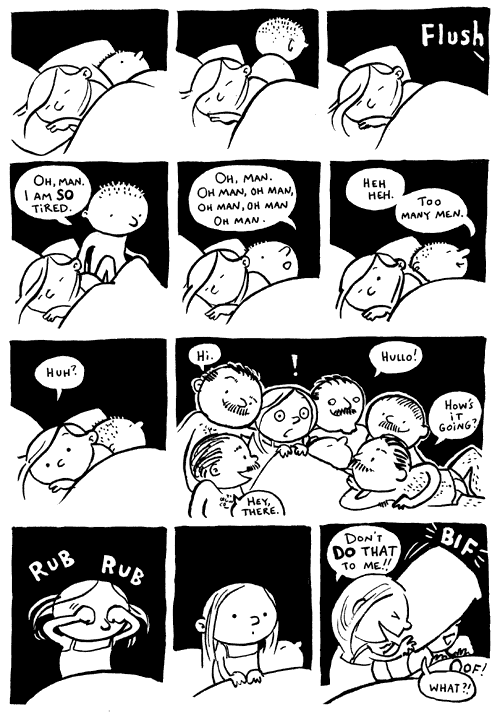



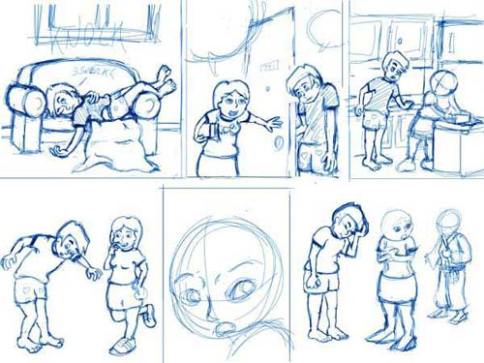

Haha...sinister and cool! I'm enjoying getting those Facebook updates btw. Keep 'em comin'!